I bought Notion3 and Miroslav new.
To get these two together is just a PAIN. Both are excellent but there is no way for me to make them work.
I looked through the archives and found no previous relevant answers.
So, how do I get Notion3 to even see Miroslav Philharmonic ?
I have Scores which is known to work with Notion3 and Miroslav, and when I play them here, Notion3 gives me thousands of popup boxes saying it cannot find sounds.
Notion3 is IMO THE software ever development for notation, but heck, it would be nice to have tutorials integrating the two as it is really a pain.
- It is currently Tue Dec 30, 2025 9:14 am • All times are UTC - 5 hours [ DST ]
Attention:
Welcome to the old forum. While it is no longer updated, there is a wealth of information here that you may search and learn from.
To partake in the current forum discussion, please visit https://forums.presonus.com
Notion3 And Miroslav
14 posts
• Page 1 of 2 • 1, 2
Re: Notion3 And Miroslav
retnev wrote:I bought Notion3 and Miroslav new.
To get these two together is just a PAIN. Both are excellent but there is no way for me to make them work.
I looked through the archives and found no previous relevant answers.
So, how do I get Notion3 to even see Miroslav Philharmonic ?
I have Scores which is known to work with Notion3 and Miroslav, and when I play them here, Notion3 gives me thousands of popup boxes saying it cannot find sounds.
Notion3 is IMO THE software ever development for notation, but heck, it would be nice to have tutorials integrating the two as it is really a pain.
Miroslav Philharmonik (IK Multimedia) works very nicely with both NOTION 3 and the 32-bit version of NOTION 4, and there are predefined templates for Miroslav Philharmonik in NOTION 3 . . .
When everything is correctly installed, it will work very nicely, so it is just a matter of determining the specific cause of the problem, which should be easy to do . . .
Toward the goal of determining the cause of the problem, the first thing to do is to start the standalone version of Miroslav Philharmonik and determine if it has any sampled sounds . . .
If you are doing digital music production on the Mac, you will find the standalone version of Miroslav Philharmonik in the "Applications" folder where the executable program will be "Miroslav Philharmonik.app", and this is what you will run . . .
If you are working on a Windows machine, then it will be similar, except that the the program probably will be an "*.exe" file, and the directory (a.k.a., "folder") location and name will be a bit different . . .
Once you start Miroslav Philharmonik, you should see a list of instruments in the right column, but if there are no instruments, then there are two possibilities:
(1) You have not downloaded and installed the sample sounds library (a.k.a., "instruments") . . .
If it is the first case, then you need to download and install the sampled sounds library . . .
OR
(2) The instruments are installed by Miroslav Philharmonik does not know where to find them . . .
If it is the second case, then you need to tell Miroslav Philharmonik where to find the installed instruments, and you do this by clicking on "PREFS" in the Miroslav Philharmonik standalone user interface, which displays a dialog message with a "Browse" button that you can use to browse or navigate to the correct location for the sampled sounds . . .

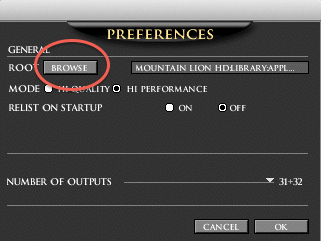
THOUGHTS
Do these tests first, and post the results. If you purchased Miroslav Philharmonik at the IK Multimedia website as an electronic download, then you need to register it and to go to your IK Multimedia User Area where you will find links to the separate download for the sampled sounds, as shown in the following screen capture . . .
[NOTE: The "Download" buttons at the top-right are for the application only. The download for sounds is found when you expand the "Sounds" section, which is found at the left side of the screen . . . ]
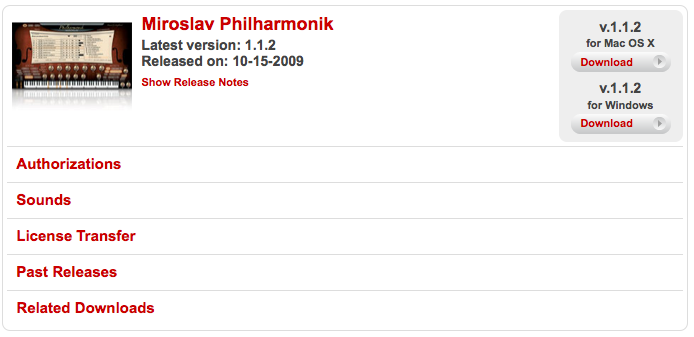
IK Multimedia User Area: Miroslav Philharmonik
There can be several reasons for not finding the sampled sounds, but most of the time it is because either (a) the sampled sounds are not installed on the computer or (b) Miroslav Philharmonik does not know where they are installed on the computer . . .
When NOTION 3 reports that the sampled sounds or "instruments" for Miroslav Philharmonik cannot be found, it actually is passing along the error message from Miroslav Philharmonik, and it is Miroslav Philharmonik that cannot find its sounds that is the problem, so get it working with the standalone version of Miroslav Philharmonik first . . .
However, if you are opening a saved NOTION 3 score that has Miroslav Philharmonik VSTi virtual instruments that specify their sampled sounds as being in a different location from the location on your computer, this might be a problem, as well, where as an example since SampleTank (IK Multimedia) is the engine for all the IK Multimedia virtual instruments, including Miroslav Philharmonik, where the apparently separate virtual instruments actually are just "skins" or "visual wrappers" on the SampleTank engine, you can move all the IK Multimedia sampled sound libraries to the SampleTank instruments folder and use SampleTank for everything, but if you do this and later decide to move the sampled sounds back to their original locations, a NOTION 3 or 32-bit NOTION 4 score that refers to SampleTank as the provider for all the sampled sounds will report that some or all of them cannot be found, which is because they were there but then sometime later you moved them. However, since creating this scenario requires you to understand the way IK Multimedia sampled sounds are stored, you most likely will know how to correct the problem, and I mention this only to provide the clue that there are instances where sampled sounds were moved and neither NOTION nor SampleTank knows where to find them . . .
The most likely scenarios are the two listed at the start of this reply, but it is possible that an existing NOTION 3 score using Miroslav Philharmonik might not be able to find the sampled sounds if they were installed to a non-standard location, although perhaps not . . .
If everything is installed to default locations, then it works very nicely. It also works very nicely if you decide to install stuff to non-standard locations, but depending on how you do a non-standard install, you might not be able to share NOTION 3 scores so easily, even though everyone has all the required applications and sampled sounds . . .
So, do the first two tests (see above), and let us know the results, which should be that everything is working very nicely, where as noted the two most likely scenarios are (a) that you did not install the sampled sounds or (b) that Miroslav Philharmonik does not know where you installed the sampled sounds, and the solution for both problems is provided in this post . . .
Lots of FUN!
-
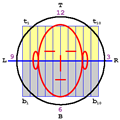
Surfwhammy - Posts: 1137
- Joined: Thu Oct 14, 2010 4:45 am
Re: Notion3 And Miroslav
Thank you for the detailed reply.
I will work through your suggestions, it will take a while.
I will work through your suggestions, it will take a while.
- retnev
- Posts: 20
- Joined: Wed Oct 16, 2013 4:10 pm
Re: Notion3 And Miroslav
Submitted answer in wrong thread, please ignore
- retnev
- Posts: 20
- Joined: Wed Oct 16, 2013 4:10 pm
Re: Notion3 And Miroslav
I checked and all is installed as you mentioned in your response.
If I bring up Miroslav, then all the entries are in the right hand side as listed. All the sounds that came with DVD-2 of Miroslav is installed.
However when I start Notion, and load the piece that is verified to be working with Miroslav, it still gives me that it cannot find the sounds and there are 10's of successive popups for the large score.
Just trying to play it gives me a huge mess. It almost echoes and repeats garbage.
To Add, All the examples that came with Notion plays properly with no problems. It is as soon as I try anything associated with Miroslav that causes the trouble. I never liked anything I ever used from IK, it has always been a "song and a dance", but unfortunately I need Miroslav for this score.
Everything else in Notion works fine and I am happy with Notion as long as I dont associate it with any IK plugins.
The Score has 20 parts. Of which only three of the parts need Miroslav. If I replace the Miroslav instruments with Notion3 the score plays without issue. If I add Miroslav instruments the thing chokes and I get a huge echo repeat mess.
The most curious though is that when I start the score I get Italian popup box "Attenzione" which tells me that it cannot find instruments 1-16. It repeats these 16 error messages about 10 times before the score loads.
I disabled 19 out of the 20 instruments in the score, leaving me with one violin .. a single instrument and a score with one instrument. The first 4 bars of violin is completely empty. Yet when I play it with Notion, Notion makes instrument noises. This is completely absurd !
There is clearly a problem with Notion. It seems like a memory violation of sorts as Notion plays instruments that does not exist on the score !!
If I bring up Miroslav, then all the entries are in the right hand side as listed. All the sounds that came with DVD-2 of Miroslav is installed.
However when I start Notion, and load the piece that is verified to be working with Miroslav, it still gives me that it cannot find the sounds and there are 10's of successive popups for the large score.
Just trying to play it gives me a huge mess. It almost echoes and repeats garbage.
To Add, All the examples that came with Notion plays properly with no problems. It is as soon as I try anything associated with Miroslav that causes the trouble. I never liked anything I ever used from IK, it has always been a "song and a dance", but unfortunately I need Miroslav for this score.
Everything else in Notion works fine and I am happy with Notion as long as I dont associate it with any IK plugins.
The Score has 20 parts. Of which only three of the parts need Miroslav. If I replace the Miroslav instruments with Notion3 the score plays without issue. If I add Miroslav instruments the thing chokes and I get a huge echo repeat mess.
The most curious though is that when I start the score I get Italian popup box "Attenzione" which tells me that it cannot find instruments 1-16. It repeats these 16 error messages about 10 times before the score loads.
I disabled 19 out of the 20 instruments in the score, leaving me with one violin .. a single instrument and a score with one instrument. The first 4 bars of violin is completely empty. Yet when I play it with Notion, Notion makes instrument noises. This is completely absurd !
There is clearly a problem with Notion. It seems like a memory violation of sorts as Notion plays instruments that does not exist on the score !!
- retnev
- Posts: 20
- Joined: Wed Oct 16, 2013 4:10 pm
Re: Notion3 And Miroslav
retnev wrote:I checked and all is installed as you mentioned in your response.
If I bring up Miroslav, then all the entries are in the right hand side as listed. All the sounds that came with DVD-2 of Miroslav is installed.
It is good that you see all the instruments listed in the right-hand side when you run Miroslav Philharrmonik in standalone mode, and this indicates that the instruments are installed correctly . . .
As a tip, you can go to "PREFS" in the standalone version of Miroslav Philharmonik and set the "RELIST ON STARTUP" option to "OFF", since you only need to do a "RELIST" when you are adding new instruments to the library. This saves time when Miroslav Philharmonik starts, and you also want to set the option for "MODE" to "HI QUALITY", at least before you render or generate the final audio for the song. "HI QUALITY" uses more computer resources, but it produces the best quality sound . . .
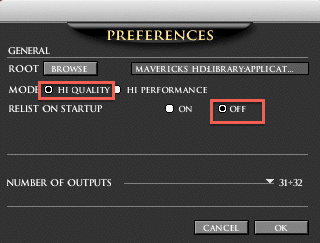
Miroslav Philharmonik Preferences ~ Options
retnev wrote:However when I start Notion, and load the piece that is verified to be working with Miroslav, it still gives me that it cannot find the sounds and there are 10's of successive popups for the large score.
Just trying to play it gives me a huge mess. It almost echoes and repeats garbage.
This is a bit puzzling, but there are several possible explanations, one of which is that if you got the score from someone else, that person might have been using custom user-defined presets, each of which is called a "COMBI", and if this is the case, there might be problems with one or more of the presets, where this explanation is based on the equally strange warning message in Italian regarding not being able to find instruments 1 through 16 (see below) . . .
Another possibility is that if the original version of the score was done with NOTION SLE for Miroslav Philharmonik and then later "converted" to NOTION 3 (full version), there can be problems, since there are differences. I started with NOTION SLE for Miroslav Philharmonik and then upgraded to NOTION 3 a few weeks later, and some of the initial scores I created had problems when I moved everything to NOTION 3, although this certainly could have been due not understanding all the rules, since everything about it was new at the time, but regardless I recall having some problems that I resolved by using the VSTi virtual instrument flavors rather than the predefined templates and so forth . . .
Yet another possibility is that there are too many instruments for the NOTION 3 to handle in its 32-bit application workspace, which happens in Mac OS X and Windows . . .
If you can use the predefined templates, then this helps, but once you exceed the total number of instruments and VST effects plug-ins that fit into the 32-bit application workspace, everything becomes vastly unpredictable, and the solution is to streamline the score or separate it into subscores and then to use ReWire to get the NOTION 3 generated audio recorded as "tracks" or "soundbites" in a Digital Audio Workstation (DAW) application, which is the strategy I continue to use, since (a) I like to have hundreds of instruments for a song and (b) even with the 64-bit version of NOTION 4 there are limits to the total number of instruments and VST effects plug-ins one can have in a score, where at present on the 2.8-GHz 8-core Mac Pro (Early 2008) with 20GB of memory, the upper limit for a score that uses MachFIve 3 (MOTU), Addictive Drums (XLN Audio), and Twin 2 (FabFilter Software Instruments) is approximately 10 instruments with about the same number of heavy VST effects plug-ins . . .
This might not appear to be so wonderful, but some of the MachFive 3 VSTi virtual instruments I am using are very heavy, which maps in some instances to as many as 10,000 individual samples for a single instrument, which takes perhaps 30 seconds to a minute to load into memory, which is fine with me and is something I consider to be reasonable and expected . . .
Some or perhaps all of the MachFIve 3 instruments are chromatically sampled (which is excellent), and a few of the instruments have separate samples for specific articulations, as well as the ability to do scripting, but they are surprisingly realistic, hence it takes a while to load and uses a lot of computer resources, but it sounds very good, which is fine with me . . .
retnev wrote:To Add, All the examples that came with Notion plays properly with no problems.
Excellent!
retnev wrote:It is as soon as I try anything associated with Miroslav that causes the trouble. I never liked anything I ever used from IK, it has always been a "song and a dance", but unfortunately I need Miroslav for this score.
Everything else in Notion works fine and I am happy with Notion as long as I dont associate it with any IK plugins.
My experience is a bit different, and I am very happy with all the IK Multimedia virtual instruments, except that at present all of them are 32-bit only, which is annoying, but the most current information from IK Multimedia is that they are going to release the 64-bit version of SampleTank this year, where for reference SampleTank is the engine for all the IK Multimedia virtual instruments, and for example Miroslav Philharmonik actually is a GUI "wrapper" for the SampleTank engine, which explained in simple terms maps to Miroslav Philharmonik being SampleTank but with a different graphic background and theme . . .
All the Miroslav Philharmonik instruments work nicely with SampleTank, and you actually have more options when you use SampleTank as the engine and host for the various IK Multimedia virtual instruments, where as I recall the primary difference is that SampleTank supports global macros or something similar . . .
retnev wrote:The Score has 20 parts. Of which only three of the parts need Miroslav. If I replace the Miroslav instruments with Notion3 the score plays without issue. If I add Miroslav instruments the thing chokes and I get a huge echo repeat mess.
The most curious though is that when I start the score I get Italian popup box "Attenzione" which tells me that it cannot find instruments 1-16. It repeats these 16 error messages about 10 times before the score loads.
NOTION 3 can handle 20 instruments, so long as no more than perhaps 1 of them is MachFive 3 (32-bit), and since you want to use a combination of NOTION 3 virtual instruments and Miroslav Philharmonik VSTi virtual instruments, I think that you are within the general range that I use, which is 20 to 25 VSTi virtual instruments per NOTION 3 score . . .
I did some experiments a few years ago, and the upper limit is approximately 50 VSTi virtual instruments, but everything becomes very strange with that number of VSTi virtual instruments, so I lowered the maximum accordingly, and for reference this is with no VST effects plug-ins, all of which is due to the 32-bit application workspace limitation for Mac OS X and Windows, since NOTION 3 is a 32-bit application . . .
Getting message in Italian is a bit odd, but perhaps you are in Europe . . .
I have not seen any IK Multimedia error or warning messages in Italian, and I use all their computer products (no mobile stuff, though) . . .
retnev wrote:I disabled 19 out of the 20 instruments in the score, leaving me with one violin .. a single instrument and a score with one instrument. The first 4 bars of violin is completely empty. Yet when I play it with Notion, Notion makes instrument noises. This is completely absurd !
There is clearly a problem with Notion. It seems like a memory violation of sorts as Notion plays instruments that does not exist on the score !!
I am not certain how one "disables" an instrument in NOTION 3, but you can make instrument staves invisible, which does not disable the instruments . . .
You can "mute" an instrument in the NOTION 3 Mixer, and this might "disable" the instrument, but perhaps not . . .
The best way to do this experiment is to create a new NOTION 3 score, starting with a blank score and adding instruments so that you have just a few instruments, which can be a mix of NOTION 3 virtual instruments and Miroslav Philharmonik VSTi virtual instruments . . .
Once you do that, you can copy the music notation for the respective instruments from the original NOTION 3 score, and this should work with no problems for a handful of instruments . . .
~ ~ ~ Continued in the next post ~ ~ ~
-

Surfwhammy - Posts: 1137
- Joined: Thu Oct 14, 2010 4:45 am
Re: Notion3 And Miroslav
~ ~ ~ Continued from the previous post ~ ~ ~
QUESTIONS AND THOUGHTS
(1) Are you doing this on the Mac or Windows, noting that some basic information about your computer will be helpful (processor, memory, and the version of Mac OS X or Windows)?
(2) If you start with a blank NOTION 3 score and add two Miroslav Philharmonik VSTi virtual instruments, are there any problems?
[NOTE: I am being very specific about using the VSTi virtual instrument flavors of Miroslav Philharmonik, which is done as shown in the following screen capture. In particular, this does not use the predefined Miroslav Philharmonik templates, which is very important for this experiment. You do not want to use the Miroslav Philharmonik predefined templates for this experiment. When you click of the fly-out box to the left, this launches the visual interface for Miroslav Philharmonik, and this is where you select the specific instrument you want to use. When you have selected the instrument or "COMBI", you can close it by clicking on the red dot (Mac OS X) or red "X" (Windows), and then NOTION 3 creates the staff in the score, but the name of the instrument will be "Miroslav Philharmonik" unless you change the name, which the way I do it. And for reference, I do not use any of the predefined factory templates. Instead, if I need a template, then I create my own custom user-defined scores and use them as "templates", where I open the score and then immediately do a "Save As . . ." to give it the name of the new song . . . ]
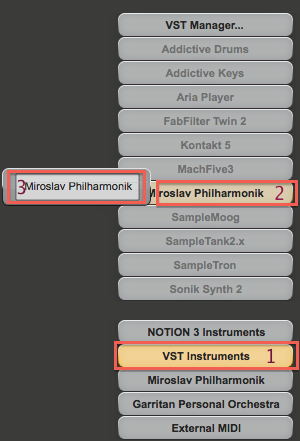
(3) If possible, can you post a link to the NOTION 3 score that is not working? This way I can experiment with it and perhaps discover the cause of the problem, where the key is to have just a few measures of actual music notation. If the score has hundreds of measures, you can make a copy of it and then using the copy delete all but perhaps 8 or so measures, but include all the instruments . . .
If you are doing this on an older computer, then it might be that the computer itself is not fast enough or whatever . . .
Knowing some basic information about the computer and the operating system will be helpful, but mostly just the version of the operating system and some information about the processor and memory, which is sufficient to get a sense of whether the computer is part of the problem . . .
You should have no problems using NOTION 3 and Miroslav Philharmonik, and there should be a solution to the problems you are having . . .
If you are doing everything on a Windows computer, I cannot provide a lot of technical help, but if you are doing everything on the Mac, then I should be able to provide some specific help . . .
At present, I am running Mac OS X 10.9 (Mavericks), and everything is working very nicely here in the sound isolation studio . . .
The first time I did the Mavericks update, there were problems, but the problems were caused by the goofy way I cloned a hard drive, so I redid everything and cloned the new hard drive correctly, which solved the problems . . .
Lots of FUN!
P. S. The reason that I need to have a lot of instruments is that I use a technique I call "Sparkling", which involves taking the notes of a single instrument and then spreading them over as many as 8 staves, where each staff is panned to a specific location on what I call the "Rainbow Panning Arc™", which runs from far-left to top-center to top-right . . .
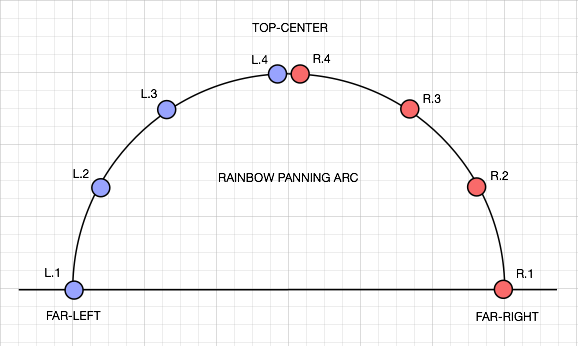
[NOTE: The top staff is "L.1 Synth", and the locations correspond approximately to the locations indicated on the diagram of the Rainbow Panning Arc . . . ]
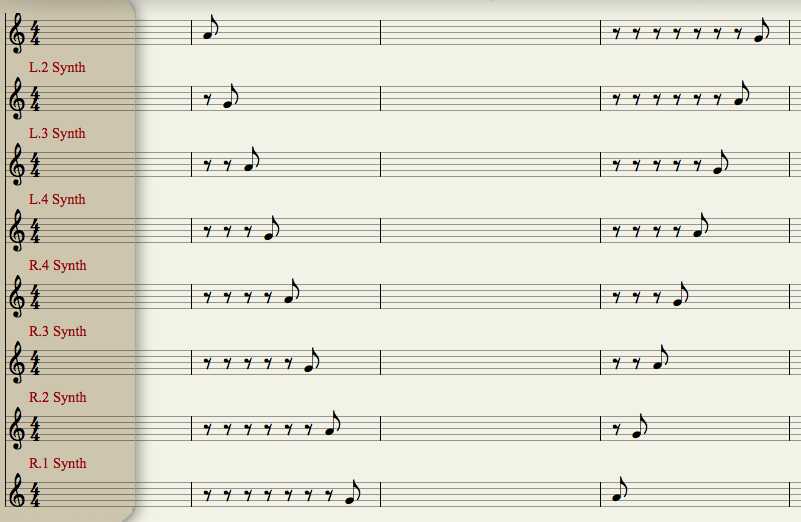
Sparkled Psaltery Harp ~ Music Notation
This puts the notes into motion, so that instead of the instrument being located in only one place, its notes appear in different locations within what I call the "Spherical Sonic Landscape™", where my avatar for this FORUM is one of the three vector planes of the Spherical Sonic Landscape and is the vector plane that one might see if one were sitting in a chair at the back of one's mind watching the notes on a patently surreal motion picture screen . . .
The other two vector planes are the view from the side and the view from the top looking downward as if you were in a miniature helicopter, which basically is three-space over time . . .
This song is done in NOTION 3, and it has three instruments (a "sparkled" Psaltry Harp and two bass synthesizers which are not "sparkled", all of which are IK Multimedia VSTi virtual instruments . . . .
[NOTE: These are two of the vector planes (front looking forward and top looking downward). I am working o the side perspective, which is more difficult for me to draw, but these two are sufficient to understand the mathematics, acoustic physics, and so forth, where for reference the lower-case characters refer to top, back, anterior, and posterior; the outer numbers are wall-clock time locations, and so forth . . . ]

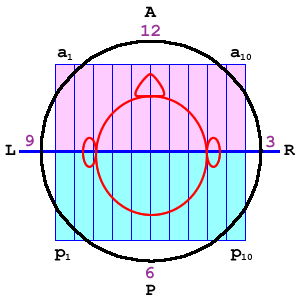
[NOTE: If you listen with headphones, you will hear motion of the Psaltry Harp notes as they move from one panning position to another, and this is done by spreading the notes over 8 staves, which takes about two hours but works very nicely, because NOTION 3 and NOTION 4 have true stereo panning controls, hence everything is very precise. The rules for panning are a bit complex, and it takes a bit of experimenting to discover how to position everything since there is a logarithmic relationship among panning, volume, and so forth, but it makes sense after a while when you do a bit of research and discover the various "panning rules". From the perspectives of mathematics and geometry, the general idea is to create dynamic curl for the DISCO and Pop songs to which the so-called "Youth of Today" enjoy listening during their ongoing mating rituals, which if nothing else is one of the many things one can do with a university education and a lot of free time with nothing else to do and plenty of very strong coffee . . . ]
]
"Sparkles" (The Surf Whammys) -- MP3
This is the prototype basic rhythm section for a new Pop song I am developing in NOTION 4 (64-bits), which is fabulous . . .

[NOTE: The instruments are a blend of NOTION 4 virtual instruments and Addictive Drums(XLN Audio), MachFive 3 (MOTU), and Twin 2 (FabFilter Software Instruments) VSTi virtual instruments. The primary VST effects plug-ins are from FabFilter Software Instruments, IK Multimedia, and Wave Arts. The primary synthesizer is Twin 2, which is stellar, and I use Timeless 2 (FabFilter Software Instruments) for advanced custom echoes. At present there are only 10 instruments, and only the two MachFive 3 Fender Jazz Basses are "sparkled". The other "sparkling" is done via Timeless 2 and the presets for the Twin 2 synthesizer. And everything is done with music notation in NOTION 4, although later I will switch to Digital Performer 8 (MOTU) for advanced producing, embellishing, and enhancing . . . ]
"The Cock-A-Doodle Oodle Dance" (The Surf Whammys) -- CueMix FX (MOTU) Phase Analysis of the Prototype Basic Rhythm Section -- YouTube music video
Fabulous!
QUESTIONS AND THOUGHTS
(1) Are you doing this on the Mac or Windows, noting that some basic information about your computer will be helpful (processor, memory, and the version of Mac OS X or Windows)?
(2) If you start with a blank NOTION 3 score and add two Miroslav Philharmonik VSTi virtual instruments, are there any problems?
[NOTE: I am being very specific about using the VSTi virtual instrument flavors of Miroslav Philharmonik, which is done as shown in the following screen capture. In particular, this does not use the predefined Miroslav Philharmonik templates, which is very important for this experiment. You do not want to use the Miroslav Philharmonik predefined templates for this experiment. When you click of the fly-out box to the left, this launches the visual interface for Miroslav Philharmonik, and this is where you select the specific instrument you want to use. When you have selected the instrument or "COMBI", you can close it by clicking on the red dot (Mac OS X) or red "X" (Windows), and then NOTION 3 creates the staff in the score, but the name of the instrument will be "Miroslav Philharmonik" unless you change the name, which the way I do it. And for reference, I do not use any of the predefined factory templates. Instead, if I need a template, then I create my own custom user-defined scores and use them as "templates", where I open the score and then immediately do a "Save As . . ." to give it the name of the new song . . . ]

(3) If possible, can you post a link to the NOTION 3 score that is not working? This way I can experiment with it and perhaps discover the cause of the problem, where the key is to have just a few measures of actual music notation. If the score has hundreds of measures, you can make a copy of it and then using the copy delete all but perhaps 8 or so measures, but include all the instruments . . .
If you are doing this on an older computer, then it might be that the computer itself is not fast enough or whatever . . .
Knowing some basic information about the computer and the operating system will be helpful, but mostly just the version of the operating system and some information about the processor and memory, which is sufficient to get a sense of whether the computer is part of the problem . . .
You should have no problems using NOTION 3 and Miroslav Philharmonik, and there should be a solution to the problems you are having . . .
If you are doing everything on a Windows computer, I cannot provide a lot of technical help, but if you are doing everything on the Mac, then I should be able to provide some specific help . . .
At present, I am running Mac OS X 10.9 (Mavericks), and everything is working very nicely here in the sound isolation studio . . .
The first time I did the Mavericks update, there were problems, but the problems were caused by the goofy way I cloned a hard drive, so I redid everything and cloned the new hard drive correctly, which solved the problems . . .
Lots of FUN!
P. S. The reason that I need to have a lot of instruments is that I use a technique I call "Sparkling", which involves taking the notes of a single instrument and then spreading them over as many as 8 staves, where each staff is panned to a specific location on what I call the "Rainbow Panning Arc™", which runs from far-left to top-center to top-right . . .

[NOTE: The top staff is "L.1 Synth", and the locations correspond approximately to the locations indicated on the diagram of the Rainbow Panning Arc . . . ]

Sparkled Psaltery Harp ~ Music Notation
This puts the notes into motion, so that instead of the instrument being located in only one place, its notes appear in different locations within what I call the "Spherical Sonic Landscape™", where my avatar for this FORUM is one of the three vector planes of the Spherical Sonic Landscape and is the vector plane that one might see if one were sitting in a chair at the back of one's mind watching the notes on a patently surreal motion picture screen . . .
The other two vector planes are the view from the side and the view from the top looking downward as if you were in a miniature helicopter, which basically is three-space over time . . .
This song is done in NOTION 3, and it has three instruments (a "sparkled" Psaltry Harp and two bass synthesizers which are not "sparkled", all of which are IK Multimedia VSTi virtual instruments . . . .
[NOTE: These are two of the vector planes (front looking forward and top looking downward). I am working o the side perspective, which is more difficult for me to draw, but these two are sufficient to understand the mathematics, acoustic physics, and so forth, where for reference the lower-case characters refer to top, back, anterior, and posterior; the outer numbers are wall-clock time locations, and so forth . . . ]


[NOTE: If you listen with headphones, you will hear motion of the Psaltry Harp notes as they move from one panning position to another, and this is done by spreading the notes over 8 staves, which takes about two hours but works very nicely, because NOTION 3 and NOTION 4 have true stereo panning controls, hence everything is very precise. The rules for panning are a bit complex, and it takes a bit of experimenting to discover how to position everything since there is a logarithmic relationship among panning, volume, and so forth, but it makes sense after a while when you do a bit of research and discover the various "panning rules". From the perspectives of mathematics and geometry, the general idea is to create dynamic curl for the DISCO and Pop songs to which the so-called "Youth of Today" enjoy listening during their ongoing mating rituals, which if nothing else is one of the many things one can do with a university education and a lot of free time with nothing else to do and plenty of very strong coffee . . .
"Sparkles" (The Surf Whammys) -- MP3
This is the prototype basic rhythm section for a new Pop song I am developing in NOTION 4 (64-bits), which is fabulous . . .

[NOTE: The instruments are a blend of NOTION 4 virtual instruments and Addictive Drums(XLN Audio), MachFive 3 (MOTU), and Twin 2 (FabFilter Software Instruments) VSTi virtual instruments. The primary VST effects plug-ins are from FabFilter Software Instruments, IK Multimedia, and Wave Arts. The primary synthesizer is Twin 2, which is stellar, and I use Timeless 2 (FabFilter Software Instruments) for advanced custom echoes. At present there are only 10 instruments, and only the two MachFive 3 Fender Jazz Basses are "sparkled". The other "sparkling" is done via Timeless 2 and the presets for the Twin 2 synthesizer. And everything is done with music notation in NOTION 4, although later I will switch to Digital Performer 8 (MOTU) for advanced producing, embellishing, and enhancing . . . ]
"The Cock-A-Doodle Oodle Dance" (The Surf Whammys) -- CueMix FX (MOTU) Phase Analysis of the Prototype Basic Rhythm Section -- YouTube music video
Fabulous!
Last edited by Surfwhammy on Mon Nov 04, 2013 11:39 am, edited 2 times in total.
-

Surfwhammy - Posts: 1137
- Joined: Thu Oct 14, 2010 4:45 am
Re: Notion3 And Miroslav
Surfwhammy, I must thank you for the detailed answer. I cannot comment on all you answered but will later. I really appreciate your sharing of your methods and compositions and will comment on it later. Do you mean Curl as in Curl and Div operators in Differential geometry or is it an urban term?
At the moment I have pressing system problems with Notion/IK.
System:
---------
Ibm X-Server
Dual Processor Xeon both 3GHZ
Processors Dual Core, Total 4 cores.
Memory 16GB
Sound Card External (Presonus Firebox)
[Internal soundcards has been my greatest source of bus problems through the years. This machine has none on the Motherboard and I chose it for that reason.]
Operating system Windows XP
I am not a windows fan at all, and wish Notion will start compiling a version for Linux as it is an operating system that has been hyper stable for me and gives you the ability to understand underlying problems. With windows you are stuck at the application layer.
I have a lot of Macs, (Old Multicore Genesis MP, all the G's up to G5 and Mac Minis (latter which all failed after 2 years) I get too many hardware failures with Macs and stick to Ibm Servers rather than Mac hardware for reliability. OSX is nice though.
Regarding Score: Unfortunately it is a score I bought for a purpose and it is still under non-disclosure until it is published.
I will post Very specific issues with examples. In the next posts.
At the moment I have pressing system problems with Notion/IK.
System:
---------
Ibm X-Server
Dual Processor Xeon both 3GHZ
Processors Dual Core, Total 4 cores.
Memory 16GB
Sound Card External (Presonus Firebox)
[Internal soundcards has been my greatest source of bus problems through the years. This machine has none on the Motherboard and I chose it for that reason.]
Operating system Windows XP
I am not a windows fan at all, and wish Notion will start compiling a version for Linux as it is an operating system that has been hyper stable for me and gives you the ability to understand underlying problems. With windows you are stuck at the application layer.
I have a lot of Macs, (Old Multicore Genesis MP, all the G's up to G5 and Mac Minis (latter which all failed after 2 years) I get too many hardware failures with Macs and stick to Ibm Servers rather than Mac hardware for reliability. OSX is nice though.
Regarding Score: Unfortunately it is a score I bought for a purpose and it is still under non-disclosure until it is published.
I will post Very specific issues with examples. In the next posts.
- retnev
- Posts: 20
- Joined: Wed Oct 16, 2013 4:10 pm
Whitenoise with no content in measures.
Issue 1: Whitenoise with no content in measures.
Here is a flash video showing this weird behavior that is really ruining everything. As you can see it happens on a score with no notes! It uses Notion3 Flute(solo). The cursor in notion does not move when I press play because there is no notes to play, yet, it introduces periodic white noise !
"http://grossmann-venter.com/issues/Notion/Whitenoise.swf"
Paste it into your browser.
Here is a flash video showing this weird behavior that is really ruining everything. As you can see it happens on a score with no notes! It uses Notion3 Flute(solo). The cursor in notion does not move when I press play because there is no notes to play, yet, it introduces periodic white noise !
"http://grossmann-venter.com/issues/Notion/Whitenoise.swf"
Paste it into your browser.
- retnev
- Posts: 20
- Joined: Wed Oct 16, 2013 4:10 pm
Re: Notion3 And Miroslav
retnev wrote:Do you mean Curl as in Curl and Div operators in Differential geometry or is it an urban term?
Glad to help!
Yes! I was referring to curl the way it is used in mathematics, geometry, and so forth, where one way to explain the dynamic aspect is what happens if you have a thin flat plastic sheet on top of which are placed iron filings and you then move a reasonably strong magnet in some type of pattern underneath the plastic sheet, where you see the iron filings move, which provides a simplistic essentially two-dimensional snapshot of a slice of what is happening in three-space over time or whatever . . .
The relative strength of the magnetic field at any given time and location will look like a section of land where there are hills and valleys, depending on the way it is drawn and represented visually, similar to the following diagram, which in the way I am using the term "dynamic curl" might be a snapshot of an instant in time, where the bottom part with the arrows is one way to represent "curl", as is the top part that looks like a valley surrounded by curvy mountains, which is another way to explain "curl", at least in a simplistically . . .
[NOTE: This is a gradient, which is not the same as curl, but it is good way to start . . . ]

[SOURCE: Gradient (wikipedia) ]
Curl (wikipedia)
For reference, the term "dynamic curl" is something that appeared when I was writing the post, and I have no idea whether there actually is something called "dynamic curl", but I like the concept, and I think it makes a bit of sense in music, which obviously is multidimensional, hence can be represented in one way or another by vector planes and vector spaces . . .
Explained another way, if I am using curl in a way that actually is correct in mathematics, geometry, physics, and so forth, then it probably is due primarily to serendipity, but regardless I think it is useful for visualizing some of the activities one does when composing and producing music, where both activities are equally important . . .
Some folks discover everything intuitively very quickly, but I need to understand what is happening, since I like to be able to control everything, and by the time you discover how to control a practical set of "everything" for a specific instrument or voice, you realize that a song is a very complex entity where over time notes appear and then disappear in various locations at different pitches, intensities, tonal textures, and so forth and so on, and in this context I like the idea of using the term "dynamic curl" as a way to map the Gestalt in a way similar to what one might do with stars, planets, and moon with respect to gravitational fields, where the example is that if the Earth were a bowling ball, one slice or vector plane of the gravitational field in space would look like the diagram of the gradient (see above) where the bowling ball sits in the valley, except that instead of being one slice, there is a virtual festival of slices, all of which change dynamically as the Earth rotates around the Sun . . .
[NOTE: The bowling ball and rubber sheet idea for explaining gravitational fields comes from "TThe Elegant Universe: Superstrings, Hidden Dimensions, and the Quest for the Ultimate Theory" (Brian Greene, 1999), which is an excellent book on physics . . . ]
Using "The Cock-A-Doodle Oodle Dance" basic rhythm section as an example, which currently is the simple pattern "AB-AB-AB", where the slower part is "A" and the fast part is "B", the instruments are placed in a triangle with the primary synthesizer as a bar in the middle, which with a bit of graceful ducking leaves room for the vocals and other instruments, as shown in the following diagram . . .
[NOTE: The term "ducking" refers to using a compressor limiter to lower the volume level of instruments based on the volume level of a vocal track, where the instruments are lowered in volume proportionally based on the volume level of the vocal track at any given time, which causes the instruments to "duck" underneath the singing to create space when there is singing, but when the singing stops the instruments return to their normal levels, which when done gracefully is not noticed in any immediately conscious way but works very nicely to move the singing to the forefront, which also lends itself to the "dynamic curl" analogy, metaphor, or simile . . . ]
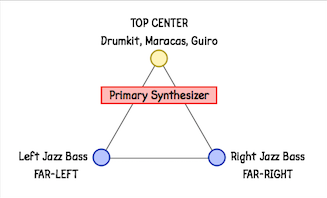
This is one way to diagram what is happening, but it is static and does not show motion, which is where the concept of "dynamic curl" is useful as a way to explain that each of the instruments is playing notes that have pitch, duration, tonal texture, and motion over time, none of which is static . . .
However, none of this explains what curl is, but so what . . .
So what!
And while curl is three-dimensional, the reason I like "dynamic curl" is that it makes it four-dimensional, which from a practical perspective is a bit too difficult for me to explain, although every once in a while I think that I can visualize it for an instant or so, which is fabulous . . .
Fabulous!
P. S. Another way to visualize the basic rhythm section for "The Cock-A-Doodle-Oodle Dance" song is to consider that it is like a snapshot of what happens when a Higgs boson is detected at the Large Hadron Collider's CMS Particle Detector, which is a curious coincidence, really . . .
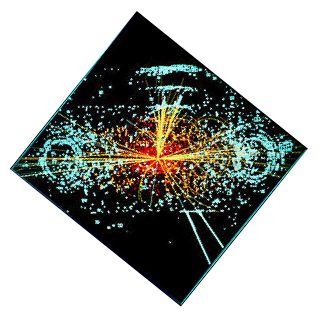
[SOURCE: Superstring Theory (wikipedia) ]
Really!
Last edited by Surfwhammy on Wed Dec 11, 2013 1:43 am, edited 1 time in total.
-

Surfwhammy - Posts: 1137
- Joined: Thu Oct 14, 2010 4:45 am
14 posts
• Page 1 of 2 • 1, 2
Who is online
Users browsing this forum: SUNWIN and 55 guests